In today’s healthcare infrastructure, smooth and secure communication is not just a convenience — it’s a vital aspect of providing better patient care. Traditional phone systems are becoming outdated; the future of healthcare communication is in Voice over Internet Protocol (VoIP).
While VoIP might sound technical and unfamiliar to some medical professionals, its advantages for medical operations are evident and measurable. This comprehensive guide will show healthcare providers and executives how to utilize VoIP to enhance their core operations, ranging from administrative duties to life-saving emergency responses.
What is healthcare VoIP?
Healthcare VoIP is implementing VoIP technology within medical facilities, clinics, and hospitals. Its unique features and adaptability make it a crucial tool for physicians, nurses, and administrative staff to communicate with each other, as well as with patients and external affiliates, in a HIPAA-compliant manner.
To know more check out our detailed article on: VoIP Explained
How does VoIP impact the healthcare sector?
The integration of VoIP in healthcare has greatly enhanced clinical operations and patient care. Studies emphasize VoIP’s crucial role in improving communication efficiency, cutting operational costs, and enhancing patient satisfaction. A study in the Journal of Medical Systems revealed that hospitals using VoIP saw a 30% drop in communication delays, aiding quicker decision-making in critical care situations.
Global Market Insights predicted the digital health market is projected to exceed a valuation of US$ 639.4 billion by 2026, showcasing the increasing reliance on digital communication tech in healthcare.
VoIP also offers substantial cost savings. According to Telzio, adopting VoIP can save 50% on telecommunication costs by eliminating traditional phone line charges and lowering maintenance expenses. VoIP’s adaptability allows healthcare providers to modify communication setups easily without the high costs associated with conventional systems.
By providing secure, reliable, and cost-efficient communication solutions, VoIP proves valuable for healthcare providers in navigating the fast-paced medical environment while complying with privacy standards like HIPAA. This shift not only enhances operational efficiency but also enhances the patient experience through timely and effective communication.
Best VoIP features for the healthcare industry
Selecting the right VoIP features is crucial for maximizing its benefits in the healthcare industry.. Here are some key VoIP features that healthcare organizations should consider:
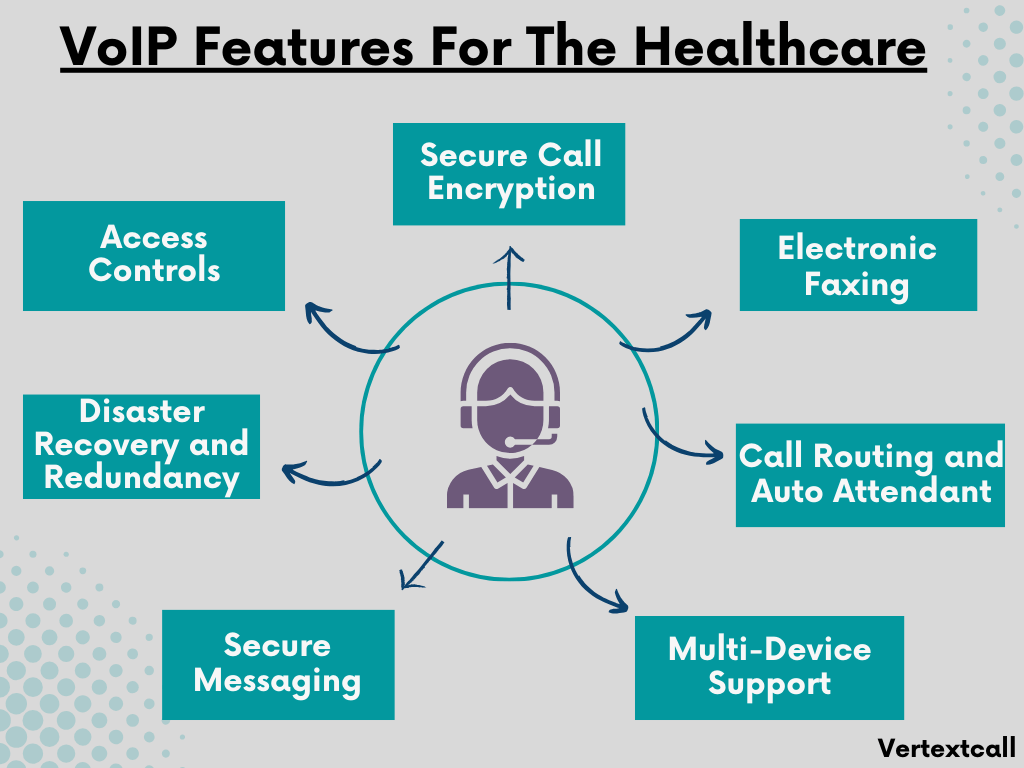
1/ Secure Call Encryption:
In the healthcare industry, one of the top priorities is securing confidential patient information in communications. The implementation of strong encryption protocols in healthcare VoIP systems is essential to protect all forms of communication from potential unauthorized access or intercepts. This encryption feature not only upholds HIPAA compliance but also protects defenses against data breaches, creating a secure setting for patient interactions and data transfer.
2/ Electronic Faxing:
Within healthcare, secure document exchange is crucial. Modernizing this through electronic faxing via VoIP systems eliminates traditional inefficiencies and risks. This advancement enables healthcare facilities to securely transmit prescriptions, patient records, and sensitive documents quickly.
3/ Call Routing and Auto Attendant:
Efficient call routing and auto-attendant features ensure that calls are directed to the appropriate department within the hospital or individual without delay. This is crucial in healthcare settings, where the speed of communication is directly linked to the quality of patient care.
4/ Multi-Device Support:
Multi-device support in VoIP technology ensures uninterrupted transition and synchronization between smartphones, tablets, desktops, and even traditional desk phones. This adaptability enables healthcare providers to maintain critical communications and access vital information, no matter their location or the device at hand.
5/ Secure Messaging:
Secure, HIPAA-compliant messaging within VoIP platforms allows for the exchange of sensitive information among medical staff. This secure communication is necessary for discussing patient care and coordinating services while ensuring privacy and confidentiality.
6/ Disaster Recovery and Redundancy:
Effective healthcare communication requires reliable infrastructure. VoIP systems with disaster recovery and failover protocols offer superior resilience.
During unexpected events like power outages or cyberattacks, these systems ensure uninterrupted healthcare operations by automatically redirecting communications to backup systems. This capability is crucial for maintaining consistent communication channels and is essential for providing timely healthcare services.
7/ Access Controls:
VoIP systems enable detailed access controls, ensuring that only authorized individuals can reach sensitive patient data via phone calls or video conferences. These measures also apply to external partners, enabling secure communication.
Key benefits of using VoIP in healthcare
Using VoIP in the healthcare environment offers numerous key benefits that enhance the efficiency, quality, and accessibility of medical services. Here are some of the most significant advantages:
1/ Cost Efficiency:
Implementing VoIP in healthcare operations offers more than just cost-saving benefits from reducing telephone expenses. By utilizing internet-based voice communication, medical facilities can cut costs associated with maintaining and upgrading traditional telephony systems.
This approach streamlines administrative processes and reallocates resources to improve patient care and invest in advanced medical technologies.
2/ Integration with Healthcare Systems:
VoIP can be integrated with electronic health records (EHRs), allowing for easier access to patient information during calls and enhancing the patient management process.
3/ Reliability and Availability:
One of the important features of VoIP technology is its reliability and the constant availability it offers for healthcare communications. Traditional phone systems can be unreliable, and affected by local outages and maintenance issues that can disrupt essential services.
Alternatively, VoIP operates on the durability of Internet infrastructure, which is more reliable and less open to localized disruptions. This ensures that healthcare providers can maintain uninterrupted communication channels, vital for emergency services and for providing continuous patient care.
4/ Improved Patient Care:
Direct and efficient communication enabled by VoIP can lead to quicker decision-making and coordination among medical staff, resulting in improved patient care and satisfaction.
5/ Mobility while service:
The integration of VoIP technology in healthcare settings allows medical staff to stay connected regardless of their physical location. Through VoIP, healthcare professionals can conveniently utilize the communication system on smartphones, tablets, or laptops, ensuring constant accessibility whether they are at the hospital, in a clinic, or on the go.
6/ Compliance with Regulatory Standards:
VoIP solutions designed for healthcare ensure compliance with HIPAA and other regulatory requirements, securing patient data during communication.
7/ Enhanced Communication:
VoIP technology enables high-quality audio and video conferencing among healthcare professionals. This advanced communication platform ensures easy connectivity and collaboration for medical staff, regardless of their locations.
By implementing VoIP, healthcare organizations can enhance patient consultations through telemedicine, support remote patient monitoring, and streamline care services coordination.
Related Reading: VoIP for Remote Workers
Applications of VoIP in healthcare
The applications of VoIP technology within the healthcare industry are vast and varied, impacting both operational efficiencies and patient outcomes. Primarily, VoIP is used for:
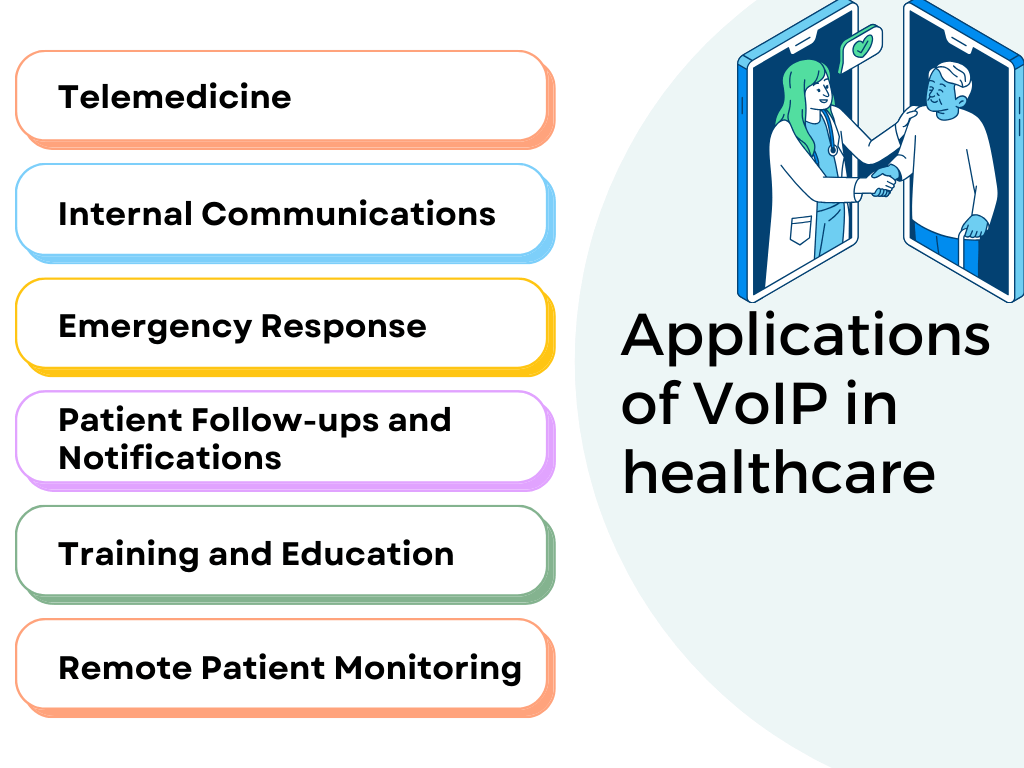
- Telemedicine: VoIP enables virtual healthcare consultations, allowing patients to access medical advice remotely. This is particularly valuable for individuals in remote areas or those unable to travel, ensuring they receive timely care without geographical constraints.
- Internal Communications: Within healthcare facilities, VoIP facilitates uninterrupted communication among staff members. Whether for coordinating patient care, discussing treatment plans, or conducting administrative discussions, VoIP’s flexibility supports instant and efficient internal dialogue.
- Emergency Response: In critical care situations, immediate communication within the hospital staff is very crucial. VoIP systems allow emergency calls to be quickly directed to the relevant departments, ensuring speedy response times.
- Patient Follow-ups and Notifications: Automated patient follow-up calls and appointment reminders can be efficiently handled via VoIP systems. This not only enhances patient engagement and adherence to treatment plans but also optimizes administrative efficiency.
- Training and Education: VoIP serves as a valuable platform for healthcare professionals to engage in ongoing training and development. Through webinars and virtual meetings, medical staff can stay updated on the latest research, techniques, and regulations without the need for physical attendance.
- Remote Patient Monitoring: VoIP can integrate with remote monitoring devices, enabling healthcare providers to monitor patients’ health in real-time. This application is especially beneficial in managing chronic conditions and minimizing the necessity for frequent hospital visits.
VoIP phone system provider for the healthcare industry
Selecting the right VoIP phone system provider is crucial for healthcare organizations to ensure effective communication and patient care. Here are the top 4 VoIP phone system providers for the healthcare industry:
1/ RingCentral:
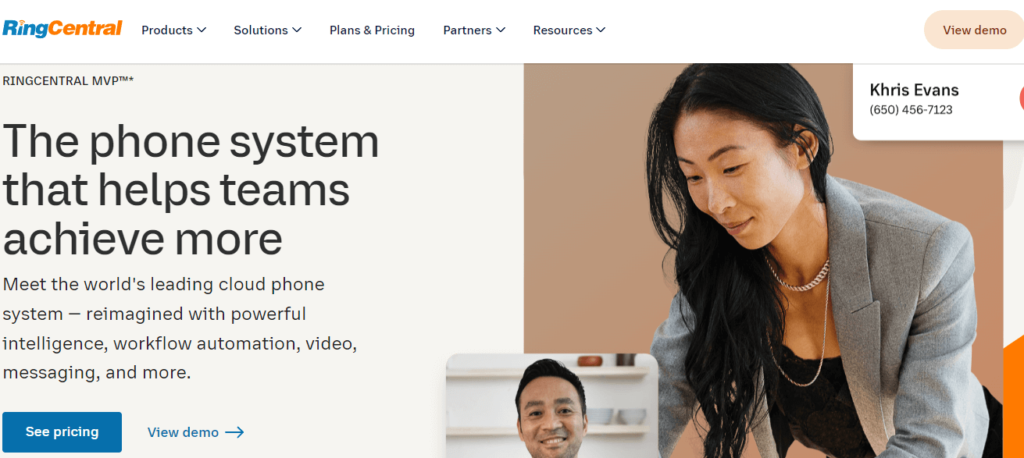
RingCentral offers a comprehensive VoIP solution tailored for the healthcare sector, with features like secure messaging, video conferencing, and easy integration with EHR systems. It facilitates efficient communication while ensuring compliance with healthcare regulations such as HIPAA.
List of Features offered:
- HIPAA-compliant communications
- Integration with EHR and healthcare management systems
- Advanced encryption and security measures
- 24/7 customer support
- User-friendly interface
- Customizable reporting options
- Multi-device synchronization
- Regular software updates
- Real-time messaging capabilities
- Automated appointment reminders
- Telehealth capabilities
- Secure file sharing
- Audit trails for compliance tracking
Pricing options vary based on the scale and needs of the healthcare provider, starting from $19.99 per user/month for the basic plan, with more advanced features available in higher-tier plans.
2/ 8×8:
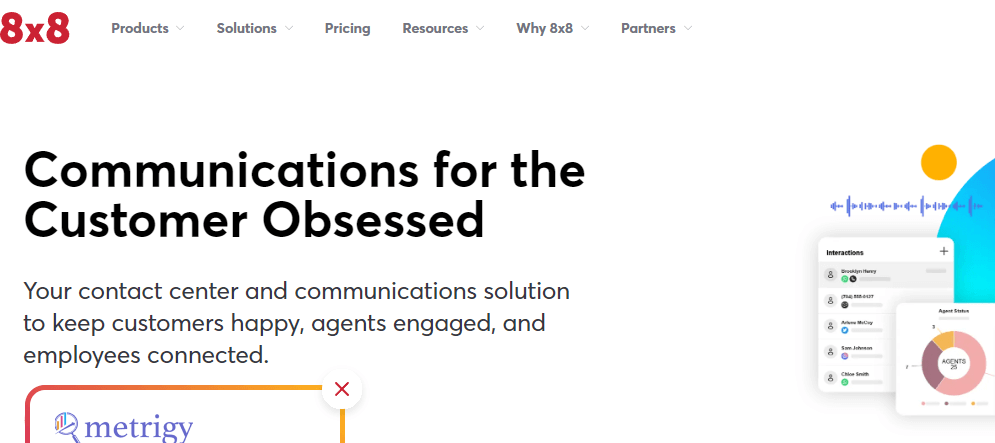
Known for its reliability and extensive feature set, 8×8 provides a VoIP phone system that supports telemedicine, multi-channel communication, and remote patient monitoring in compliance with HIPAA standards. Its analytics and reporting tools also enable healthcare facilities to improve operational efficiency.
List of Features offered:
- End-to-end encryption for data security
- HIPAA-compliant communications
- Integration with EHR and healthcare management systems
- Video conferencing and screen-sharing capabilities
- Call recording and transcription services
- Virtual faxing for secure document transfer
- Customizable IVR options for personalized caller experience
Pricing begins at $24 per user/month, with advanced features and additional compliance support available in premium packages.
3/ Nextiva:
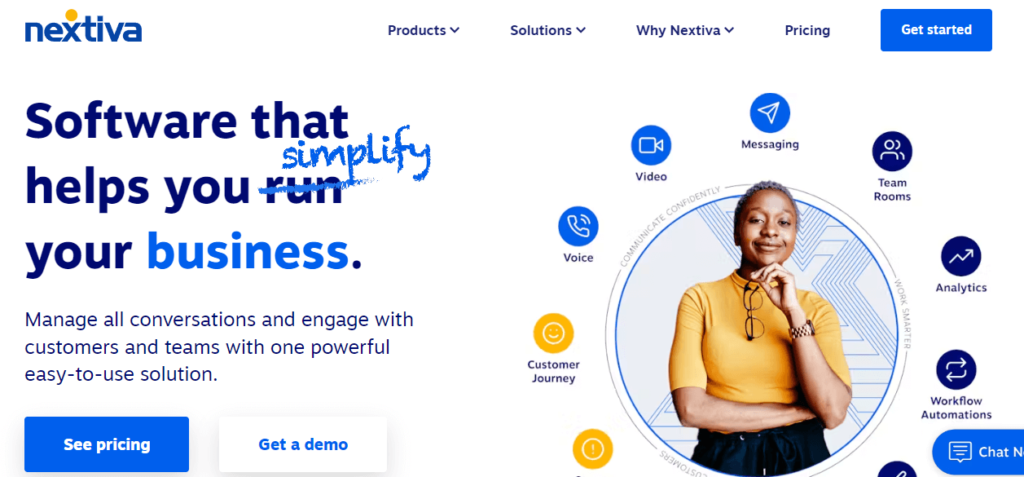
Nextiva stands out for its easy-to-use interface and exceptional customer service, alongside features that include automated appointment reminders, follow-ups, and secure communication channels. It’s designed to improve both patient satisfaction and administrative efficiency, ensuring compliance with HIPAA guidelines.
List of Features offered:
- HIPAA-compliant communications
- Integration with EHR and healthcare management systems
- Encryption for data security
- Unlimited calling and video conferencing
- Virtual faxing for secure document transfer
- Call recording and transcription services
- Customizable IVR options for personalized caller experience
Pricing for Nextiva’s VoIP services starts at $23.95 per user/month, with various tiers offering additional features and support.
4/ Ooma:
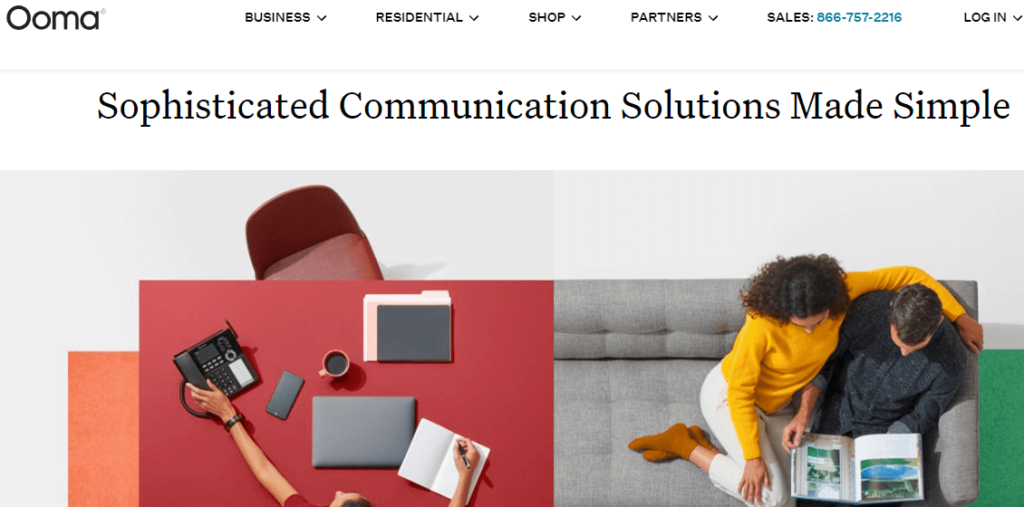
Specializing in small to medium-sized healthcare practices, Ooma offers a cost-effective yet reliable VoIP phone system with features like a virtual receptionist, extension dialing, and conference bridge. It provides a simplified solution that meets the essential communication needs of healthcare providers while ensuring security and regulatory compliance.
List of Features offered:
- HIPAA-compliant communications
- Easy integration with existing healthcare management systems
- Advanced voice and encryption protocols for enhanced security
- 24/7 customer support and monitoring
- Virtual receptionist and smart call routing
- Mobile app for on-the-go access
- Video conferencing and screen sharing for telehealth services
- Real-time analytics for call and data management
Ooma’s plans are competitively priced, starting from $20 per user/month, making it an attractive option for smaller operations.
Steps to transform your healthcare practices with VoIP
Transforming healthcare practices through VoIP technology involves a strategic, step-by-step approach to ensure integration and maximization of benefits. Here are the essential steps to achieve this transformation:
1/ Assessment and Planning: Evaluate your current communication systems and identify the areas where VoIP can make the most significant impact. This step involves understanding your healthcare facility’s needs, the challenges with the existing system, and the goals you aim to achieve with VoIP.
2/ Choosing the Right VoIP Provider: Select a VoIP provider with a proven track record in the healthcare sector. Ensure they offer features essential for healthcare practices, such as compliance with healthcare regulations (e.g., HIPAA in the United States), high-level security, and reliable customer support.
Note: The list of providers mentioned above adheres to HIPAA regulations.
3/ Training and Support: Training healthcare staff on how to use the new VoIP system effectively is essential for a smooth transition. Opting for a service that provides extensive education and continuous assistance is crucial, enabling your staff to fully exploit the capabilities offered by VoIP technology.
4/ Implementation and Integration: Work closely with your VoIP provider to implement the new system. This involves setting up the necessary hardware, integrating with existing healthcare systems (like EHR), and ensuring that all security measures are in place for patient data protection.
5/ Testing: Before fully switching to the new VoIP system, it is crucial to perform trials to ensure everything works as expected. This includes testing integration points, call quality, reliability, and the effectiveness of disaster recovery protocols.
6/ Rollout and Ongoing Evaluation: Gradually roll out the VoIP system across your healthcare practice while continuously monitoring performance and gathering feedback from users. Routine evaluations assist in identifying specific areas where improvements can be made and ensure that the VoIP system meets the evolving needs of your healthcare practice.
By following these steps, healthcare providers can effectively transform their communication practices, enhance patient care, and improve operational efficiencies through VoIP technology.
Frequently Asked Questions
Q1) What VoIP is HIPPA compliant?
Ans: Many VoIP services offer HIPAA-compliant communication options tailored for the healthcare industry. Notable examples include 8×8, Nextiva, Vonage, MegaPath, and Ooma. These services ensure the security and privacy of patient information through end-to-end encryption, secure messaging, and compliance with healthcare regulations.
Q2) Do hospitals use VoIP?
Ans: Yes, hospitals and other healthcare facilities increasingly utilize VoIP solutions for their communication needs. VoIP services offer secure, efficient, and cost-effective alternatives to traditional phone systems. With features like telehealth capabilities, integration with Electronic Health Records (EHR) systems, and multi-device synchronization.
Q3) Is spectrum VoIP HIPPA compliant?
Ans: Spectrum VoIP provides services that can be configured to support HIPAA compliance through measures such as encryption, secure data transmission, and protected voicemail. However, ensuring HIPAA compliance involves not just the technical solutions but also how the service is used within the healthcare organization.
Q4) What phone system do hospitals use?
Ans: Hospitals primarily use Voice over Internet Protocol systems for their communication needs. These systems offer a range of features beneficial for hospital operations. Additionally, VoIP systems can also be customized to meet the specific requirements of different healthcare facilities, whether small clinics or large hospitals.
Q5) How is VoIP good for healthcare communication?
Ans: VoIP technology is exceptionally beneficial for healthcare communication due to its flexibility, security, and cost-efficiency. It supports an integrated communication environment that aligns well with the dynamic needs of healthcare settings. Features such as telemedicine capabilities, secure messaging, and EHR system integration facilitate improved patient care and coordination among healthcare professionals.
The ability to use VoIP across multiple devices ensures that staff remain connected, whether they are in the hospital, at a clinic, or providing in-home care. Furthermore, VoIP solutions can be customized to enhance patient privacy and data protection, aligning with HIPAA compliance requirements.
The cost savings compared to traditional telecommunication systems make VoIP a better option for healthcare providers looking to optimize their operations while maintaining high standards of patient care and privacy.

